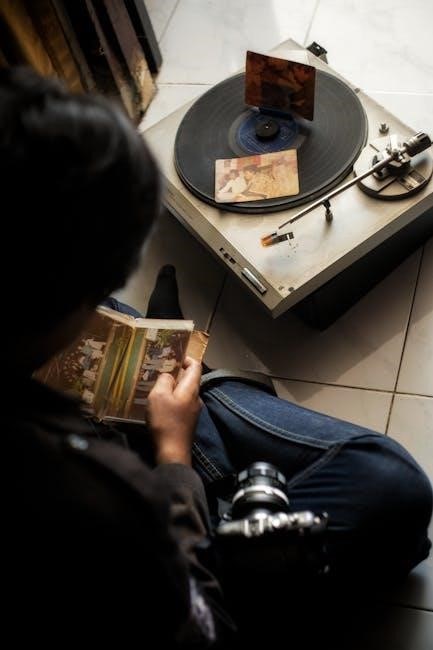
wave guide cover for microwave
A wave guide cover is a small, often mica or plastic component inside microwaves, covering the opening where microwaves enter the cooking chamber. It protects internal components from food splatter and moisture, preventing arcing and electrical issues. This essential part ensures safe and efficient microwave operation.
What is a Wave Guide Cover?
A wave guide cover is a small component located inside a microwave oven, typically on the right wall or roof of the cooking chamber; It is usually made of mica or plastic and serves as a protective barrier. This cover is designed to fit over the opening through which microwaves, generated by the magnetron, enter the cooking area. Its primary function is to prevent food particles, moisture, and splatter from entering the internal components of the microwave, ensuring safe and efficient operation. The wave guide cover plays a crucial role in maintaining the integrity of the microwave’s electrical system and preventing potential damage.
Importance of the Wave Guide Cover in Microwave Functionality
The wave guide cover is crucial for maintaining the microwave’s functionality and safety. It prevents food particles, moisture, and splatter from entering the internal components, protecting the magnetron and other delicate parts from damage. This cover also helps prevent arcing, which can occur when microwaves interact with debris on the surface. By ensuring a clean and unobstructed path for microwave energy, the wave guide cover enhances cooking efficiency and prevents electrical issues. Its presence is essential for safe and reliable operation, making it a vital component in the overall design and performance of a microwave oven.

Structure and Design of the Wave Guide Cover
The wave guide cover is typically made of heat-resistant materials like mica or plastic. It is usually a small, flat sheet located on the right side or roof of the microwave cavity, designed to fit securely over the waveguide opening.
Location and Placement in the Microwave
The wave guide cover is positioned inside the microwave cavity, typically on the right wall or roof. Its placement is strategic, covering the aperture through which microwaves travel from the magnetron to the cooking area. This location ensures it effectively blocks food particles and moisture from entering sensitive electrical components. Some microwaves may have the cover on the left side or rear, depending on the model. Proper installation is crucial to maintain microwave functionality and safety, preventing potential damage from splatters and ensuring even energy distribution for cooking.
Materials Used for Manufacturing the Wave Guide Cover
Wave guide covers are typically made from mica or plastic materials. Mica, a natural mineral, is durable, heat-resistant, and an excellent electrical insulator, making it ideal for withstanding high temperatures and microwave energy. In newer models, plastic is often used as a cost-effective alternative, offering similar protective qualities. Both materials are designed to withstand the harsh environment inside a microwave, ensuring longevity and safety. The choice of material depends on the microwave’s design and manufacturer, with mica being more common in older models and plastic in newer ones. These materials effectively prevent moisture and food particles from damaging internal components.

Functions and Purpose of the Wave Guide Cover
The wave guide cover safeguards internal components from food particles and moisture, preventing arcing and electrical issues. It ensures efficient microwave operation by directing microwaves effectively.
Protection of the Magnetron and Internal Components
The wave guide cover plays a crucial role in protecting the magnetron and internal components from food splatter and debris. By covering the aperture through which microwaves enter the cooking chamber, it prevents contaminants from reaching sensitive electrical parts; This safeguarding ensures the longevity and proper functioning of the magnetron, which is essential for generating microwaves. Without this protection, moisture and food particles could cause arcing or electrical failures, leading to costly repairs or even complete system breakdowns. Thus, the wave guide cover is vital for maintaining the microwave’s performance and safety standards.
Prevention of Food Particles and Moisture Entry
The wave guide cover acts as a barrier, preventing food particles and moisture from entering the internal components of the microwave. During cooking, splattered food and steam can easily reach the aperture where microwaves enter the cavity. If these contaminants penetrate, they can cause arcing or damage to the internal electronics. The cover’s placement ensures that such debris is blocked, maintaining the integrity of the microwave’s inner workings. This prevention is essential for sustaining the appliance’s efficiency and preventing potential malfunctions. By stopping food residue and moisture, the wave guide cover helps preserve the microwave’s performance and extends its operational lifespan.
Role in Preventing Arcing and Electrical Issues
The wave guide cover plays a crucial role in preventing arcing and electrical issues within the microwave. Arcing occurs when food particles or moisture come into contact with the wave guide, causing sparks that can damage internal components. The cover acts as a protective barrier, shielding the delicate electronics from such contaminants. Its smooth, non-conductive surface ensures that microwaves pass through safely while preventing electrical discharges. This protection is essential for maintaining the microwave’s operational safety and preventing potential hazards like electrical fires or component failure. By blocking conductive paths, the wave guide cover ensures reliable performance and extends the lifespan of the appliance.

How Microwaves Work and the Role of the Wave Guide
Microwaves generate energy through the magnetron, which is then channeled by the wave guide into the cooking chamber, ensuring efficient heating and preventing energy loss.
Basic Principles of Microwave Operation
Microwaves operate by producing high-frequency electromagnetic waves, typically in the gigahertz range, through a component called the magnetron. These waves are directed into the cooking chamber via the wave guide, where they penetrate food and cause water molecules to vibrate rapidly. This friction generates heat, cooking the food. The process relies on the dielectric properties of water, ensuring even heating. The waves bounce off the metal walls of the chamber, creating standing waves that distribute energy uniformly. This efficient transfer of energy allows microwaves to cook food quickly without excessive power consumption, making them a convenient kitchen appliance.
Channeling Microwave Energy into the Cooking Chamber
Microwave energy is channeled into the cooking chamber through a wave guide, a critical pathway for electromagnetic waves. The wave guide ensures that the high-frequency waves produced by the magnetron are efficiently directed into the cavity; As the waves enter the chamber, they reflect off the metal walls, creating a uniform energy distribution. This controlled process allows the waves to interact with food, penetrating it and causing the water molecules to heat up rapidly. The design of the wave guide and its cover prevents energy from escaping, ensuring maximum efficiency and safety. This precise channeling is essential for effective cooking and preventing energy loss.

Installation and Replacement of the Wave Guide Cover
Installation involves locating the cover, typically on the right or roof of the cavity, unplugging the microwave, and carefully removing the old cover. Replace it with a new one, ensuring proper alignment and secure installation. Always refer to the appliance manual for specific instructions and safety precautions.
Steps to Replace a Damaged Wave Guide Cover
Unplug the microwave to ensure safety while working. Locate the wave guide cover, typically on the right wall or roof of the cooking cavity. Remove the screws holding the cover in place using a screwdriver. Gently pull out the old cover and discard it. Clean the area to remove any food residue or debris. Fit the new cover into the slot, ensuring it aligns properly. Secure it with screws tightly but avoid over-tightening. Plug the microwave back in and test it to ensure proper operation. Always refer to the appliance manual for specific instructions and safety precautions.
Tools and Precautions Needed for Replacement
Essential tools: A Phillips screwdriver and a flathead screwdriver for removing screws. Gloves and safety goggles protect against sharp edges. Precautions: Always unplug the microwave to avoid electric shock. Handle the wave guide cover carefully to prevent scratches or damage. Avoid using metal utensils, which may cause sparks. Ensure the area is clean and free from debris before installing the new cover. Refer to the microwave’s manual for specific instructions. Take care not to over-tighten screws, as this might damage the surrounding material. Proper replacement ensures safety and optimal microwave functionality.
Where to Buy Replacement Covers
Replacement wave guide covers are available from various retailers, including Amazon, appliance repair shops, and manufacturer websites. For universal covers, options like eBay or home appliance stores are ideal. If purchasing online, ensure the product matches your microwave’s model. Some users prefer local hardware stores for quicker access. Be cautious of third-party sellers to avoid low-quality products. Directly buying from the microwave manufacturer guarantees compatibility. For those who prefer DIY solutions, mica sheets can be purchased and cut to size. Always check reviews and product descriptions to ensure the correct fit for your microwave model.

Maintenance and Troubleshooting Tips
Regularly clean the wave guide cover with a soft cloth to prevent food residue buildup. Avoid abrasive cleaners to maintain its protective properties. Inspect for arcing signs or soot accumulation, which may indicate damage. Address issues promptly to ensure safe and efficient microwave operation.
Cleaning the Wave Guide Cover and Surrounding Areas
To clean the wave guide cover, unplug the microwave and let it cool. Dampen a soft cloth with water, avoiding harsh chemicals or abrasive cleaners. Gently wipe the cover to remove food residue and splatters. For stubborn stains, use a plastic scraper to carefully remove debris. Avoid scratching the surface, as this can compromise its protective properties. Dry the cover thoroughly with a clean cloth to prevent moisture buildup. Regular cleaning prevents arcing and ensures efficient microwave performance. Also, clean the surrounding areas to eliminate food particles that could damage the cover or internal components over time.
Identifying Common Issues with the Wave Guide Cover
Common issues with the wave guide cover include arcing caused by food particles or moisture on its surface. This can lead to sparks and potentially damage the cover or internal components. Food residue and splatters often accumulate, creating a conductive layer that interferes with microwave energy. Over time, the cover may degrade due to high temperatures or exposure to acidic foods, reducing its effectiveness. Additionally, moisture buildup can seep behind the cover, causing electrical issues. Regular inspection for cracks, discoloration, or warped surfaces is essential to prevent these problems. If damaged, the cover may need replacement to ensure safe and efficient microwave operation.
How to Prevent Damage to the Wave Guide Cover
To prevent damage to the wave guide cover, regular cleaning is essential. Use a damp cloth to wipe away food splatters and moisture, avoiding abrasive materials that could scratch the surface. Ensure the cover is dry after cleaning to prevent moisture buildup, which can lead to arcing. Covering the wave guide during cooking can help catch splatters before they adhere. Avoid using metal utensils, as they may cause sparks. Additionally, ensure the microwave is not overloaded, as excessive heat can warp the cover. By following these steps, you can extend the lifespan of the wave guide cover and maintain efficient microwave operation.